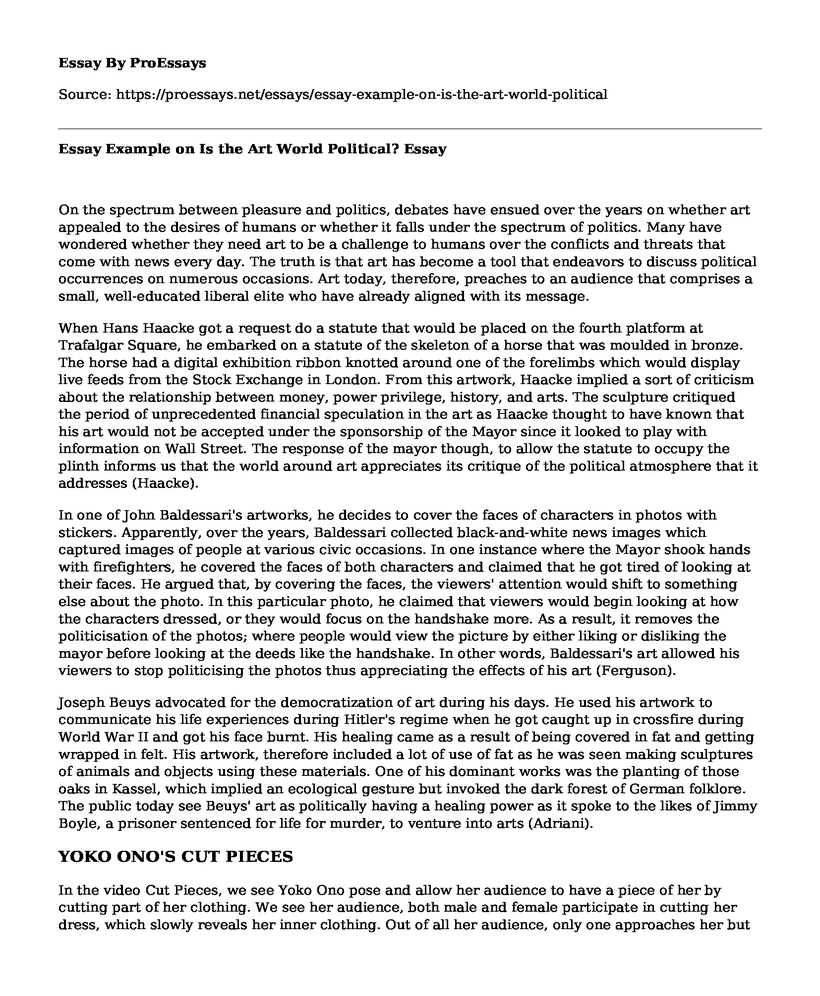On the spectrum between pleasure and politics, debates have ensued over the years on whether art appealed to the desires of humans or whether it falls under the spectrum of politics. Many have wondered whether they need art to be a challenge to humans over the conflicts and threats that come with news every day. The truth is that art has become a tool that endeavors to discuss political occurrences on numerous occasions. Art today, therefore, preaches to an audience that comprises a small, well-educated liberal elite who have already aligned with its message.
When Hans Haacke got a request do a statute that would be placed on the fourth platform at Trafalgar Square, he embarked on a statute of the skeleton of a horse that was moulded in bronze. The horse had a digital exhibition ribbon knotted around one of the forelimbs which would display live feeds from the Stock Exchange in London. From this artwork, Haacke implied a sort of criticism about the relationship between money, power privilege, history, and arts. The sculpture critiqued the period of unprecedented financial speculation in the art as Haacke thought to have known that his art would not be accepted under the sponsorship of the Mayor since it looked to play with information on Wall Street. The response of the mayor though, to allow the statute to occupy the plinth informs us that the world around art appreciates its critique of the political atmosphere that it addresses (Haacke).
In one of John Baldessari's artworks, he decides to cover the faces of characters in photos with stickers. Apparently, over the years, Baldessari collected black-and-white news images which captured images of people at various civic occasions. In one instance where the Mayor shook hands with firefighters, he covered the faces of both characters and claimed that he got tired of looking at their faces. He argued that, by covering the faces, the viewers' attention would shift to something else about the photo. In this particular photo, he claimed that viewers would begin looking at how the characters dressed, or they would focus on the handshake more. As a result, it removes the politicisation of the photos; where people would view the picture by either liking or disliking the mayor before looking at the deeds like the handshake. In other words, Baldessari's art allowed his viewers to stop politicising the photos thus appreciating the effects of his art (Ferguson).
Joseph Beuys advocated for the democratization of art during his days. He used his artwork to communicate his life experiences during Hitler's regime when he got caught up in crossfire during World War II and got his face burnt. His healing came as a result of being covered in fat and getting wrapped in felt. His artwork, therefore included a lot of use of fat as he was seen making sculptures of animals and objects using these materials. One of his dominant works was the planting of those oaks in Kassel, which implied an ecological gesture but invoked the dark forest of German folklore. The public today see Beuys' art as politically having a healing power as it spoke to the likes of Jimmy Boyle, a prisoner sentenced for life for murder, to venture into arts (Adriani).
YOKO ONO'S CUT PIECES
In the video Cut Pieces, we see Yoko Ono pose and allow her audience to have a piece of her by cutting part of her clothing. We see her audience, both male and female participate in cutting her dress, which slowly reveals her inner clothing. Out of all her audience, only one approaches her but declines to cut off her clothes. She tries to bring out a critique on the nature of humans; humans would enjoy inflicting humiliation of their fellows without thinking twice (Bryan-Wilsion 103). Her clothes getting cut off implies the shame that victims undergo, that reveals their deep despair within. Otherwise, her posture reveals the helplessness that victims experience in these humiliating moments as she does not rebel from being humiliated in public. In her piece of art, she brings out the fact that out of all people in influential positions to assist the oppressed individuals, only a tiny fraction will think twice about oppressing the minority.
Further, we see her pose without resistance to allow for cutting off her clothes, right until one of her audiences goes further to begin cutting off her inner garment before she could become uncomfortable and try to stop him from proceeding to cut her clothing off mildly. This aspect of her artwork seeks to explain the extent to which the oppressed individuals in the society today can endure oppression before they begin feeling uncomfortable and think of fighting back. The art in the video appeals to the viewers the concept of the insensitivity of the world around and sexism and other forms of oppression that goes on around the world today (Bryan-Wilsion 120).
Works Cited
Adriani, Gotz, et al. "Joseph Beuys, life and works." 1979.
Bryan-Wilsion, Julia. "Invitation, Sacrifice, Souvenir: Yoko Oko's "Cut Piece"." Oxford Art Journal 26.1 (2003): 101-123.
Ferguson, Russell, Marcia Tucker, and John Baldessari. Discourses Conversations in Postmodern Art and Culture. 1990.
Haacke, Hans. "Hans Haacke, unfinished business." 1986.
Cite this page
Essay Example on Is the Art World Political?. (2022, Jun 06). Retrieved from https://proessays.net/essays/essay-example-on-is-the-art-world-political
If you are the original author of this essay and no longer wish to have it published on the ProEssays website, please click below to request its removal:
- Detailed Description of Amite: Research Paper
- GDP and Standards of Living Between Germany and Indonesia - Research Paper
- Music in Promotional Campaigns Essay
- Essay Sample on Role of Government in Balancing Freedom, Order, and Equality
- Movie Analysis Essay on No Country for Old Men by Joel and Ethan Coen
- Symbolism in Joyas Voladoras by Brian Doyle Essay Example
- Policy Research: Applying Social Science to Solve Problems - Research Paper







